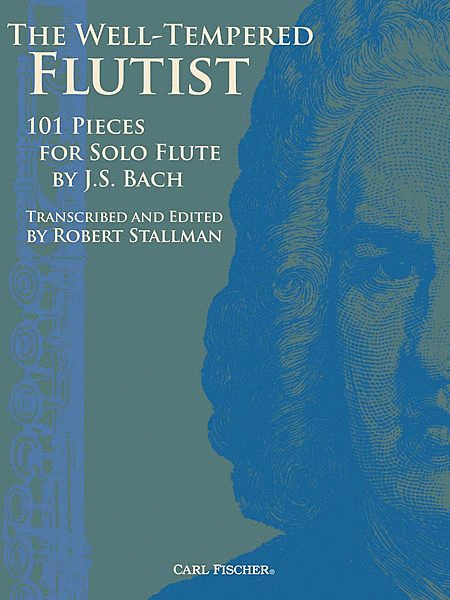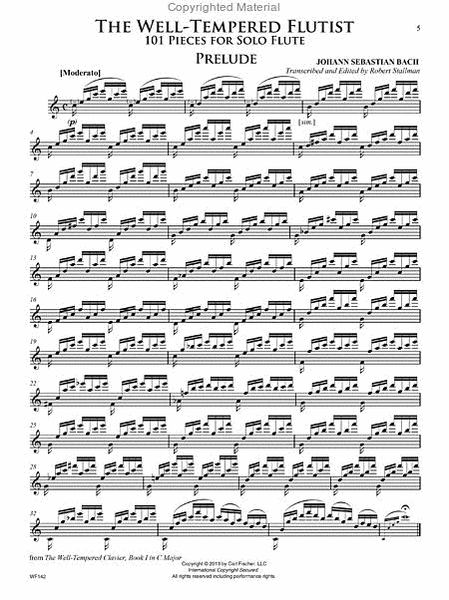The Well-Tempered Flutist
101 Pieces for Solo Flute by J.S. Bach - Trans. and Ed. by Robert Stallman
-
Ships in 1 to 2 weeks
Details
Description
SKU: CF.WF142
101 Pieces for Solo Flute by J.S. Bach - Trans. and Ed. by Robert Stallman. Composed by Johann Sebastian Bach. Arranged by Robert Stallman. Perfect Bound. Classical. Collection. With Standard notation. 116 pages. Carl Fischer Music #WF142. Published by Carl Fischer Music (CF.WF142).ISBN 9780825893339. UPC: 798408093334. 9 x 12 inches.
For Solo Fluteby J.S. BachTranscribed and Editedby Robert StallmanWF142 The Well-Tempered Flutist — Bach / StallmanWF142 — $29.99 USAISBN 978-0-8258-9333-9 UPCwww.carlfischer.com“Let the Well-Tempered Clavier be your daily bread. Then youwill certainly become a solid musician” –Robert SchumannThe compositions of Johann Sebastian Bach are essential forevery musician’s daily practice and musical development,regardless of his or her technical level. In this expertlycrafted edition, world-renowned flutist Robert Stallman hastranscribed and edited 101 works, creating “an entire worldof Bach for solo flute.” The works are drawn from the “Well-Tempered Clavier”, French and English Suites, Partitas for SoloKeyboard, as well as the Sonatas for Violin, Cello (Gamba),Flute, Lute and Organ. Designed for daily study and concertperformance, these works will serve to build both technicalmastery and musical maturity.
Judging from the wealth of extraordinary flute music Bach has left us, it is obvious that he loved our instrument. In Bach’s day, the flûte traversière, a relatively new French instrument in Germany, was sweeping Europe, attracting amateurs and professionals alike. But it was the astounding artistry of the French virtuoso Pierre-Gabriel Buffardin that first awakened Bach to the flute’s potential to handle both technically challenging and expressively profound music. The lifelong friendship between the two musicians was probably initiated in 1717 when Bach made his first visit to the royal Saxon court at Dresden, where the Frenchman was flute soloist. Written soon thereafter, Bach’s demanding Partita for Solo Flute must have been inspired by this early encounter with Buffardin—and probably pushed even Buffardin to transcend his limits. Then in 1724, on the heels of another visit to Dresden, Bach suddenly began to compose difficult and deeply moving flute solos in his cantatas for St. Thomas Church in Leipzig. And in the 1730’s, when Bach and Buffardin had occasions to perform together in both Dresden and Leipzig, there followed still more challenging works for flute: the Sonatas in B and E Minor, and the Orchestral Suite in B Minor, among others. These compositions were most likely written with Bach’s French friend in mind. At the time, only a Buffardin could have managed to play them. Ever the passionate educator, Johann Sebastian Bach would have encouraged us to borrow from his magnum opus to support our own development as flutists and musicians. In preparing this book, my intention has been to create an entire world of Bach for solo flute, all in one volume—an abundance of great music for us to explore throughout a lifetime of daily practice. In addition, many of these pieces can be programmed in performance to good effect.Nearly all of the works in this collection are presented here in print for the first time as transcriptions for solo flute. They are drawn primarily from Bach’s “Well-Tempered Clavier”, the French and English Suites and the Partitas for Solo Keyboard, as well as from the Sonatas for Violin, Cello (Gamba), Flute, Lute and Organ. I have organized these movements as an expanded Baroque suite, beginning with Preludes and Allemandes, and ending with Gigues and Allegros (providing origins and original keys at the bottom of title pages). The Bach-Gesellschaft edition has served as my primary source. Editorial markings have been minimized, with dynamics in parentheses and suggested tempos in brackets. Throughout, normal slurs are editorial, whereas broken slurs are Bach’s original indications. “Play Bach’s Preludes and Fugues every day”, said Chopin. “This is the highest and best school; no one will ever create a more ideal one…Without Bach you cannot have freedom in the fingers, nor a clear and beautiful tone.” Chopin’s famous advice to pianists pertains equally to us flutists. I would add that Bach is also essential for developing a strong sense of rhythm, lively articulation, good voicing, natural phrasing, breath control and sheer endurance. And then Bach is necessary for our souls—for “the refreshment of the spirit”, as Bach himself would put it. Actually, without a strong foundation in Bach, it is hardly possible to become a serious musician.Brahms once said, “Study Bach. There you will find everything.” Bach encompasses all of life. His music is a wellspring that continually inspires, challenges and empowers us to grow musically, whatever our level of accomplishment.


 Share
Share